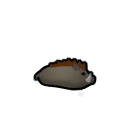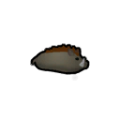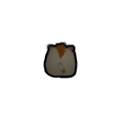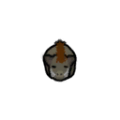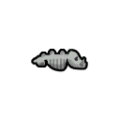Wild boar
Wild boar
This hairy omnivore is descended from escaped pigs and evolved for living in the wild.
Its tusks make it a better fighter than its domesticated pig cousins. Unfortunately, it is too unruly to be trained in the most complex tasks.
Base Stats
- Type
- Animal
- Flammability
- 70%
Pawn Stats
- Combat Power
- 55
- Move Speed
- 4.6 c/s
- Health Scale
- 0.7
- Body Size
- 0.85
- Mass - Baby
- 10.2 kg
- Mass - Juvenile
- 25.5 kg
- Mass - Adult
- 51 kg
- Carrying Capacity
- 64 kg
- Filth Rate
- 16
- Hunger Rate
- 0.48 Nutrition/Day
- Diet
- omnivorous grazer
- Life Expectancy
- 12 years
- Manhunter Chance
- 0%
- Manhunter Chance (Taming)
- 0%
- Trainable Intelligence
- None
- Wildness
- 50%
- Minimum Handling Skill
- 4
- Roam Interval
- 2 days
- Mate Interval
- 12 hours
- Maturity Age
- 0.333 years (20 days)
- Juvenile Age
- 0.1 years (6 days)
- Comfortable Temp Range
- -23 °C – 40 °C (-9.4 °F – 104 °F)
Production
- Meat Yield
- 119 pork
- Leather Yield
- 36 pigskin
- Gestation Period
- 5.661 days
- Offspring Per Birth
- 1-2 (1.25 avg)
Melee Combat
- Attack 1
- Tusk
9.7 dmg (Scratch)
15 % AP
2 second cooldown - Attack 2
- Tusk
9.7 dmg (Stab)
15 % AP
2 second cooldown - Attack 3
- Teeth
8.5 dmg (Bite)
13 % AP
2 second cooldown
0.6 chance factor - Attack 4
- Head
5 dmg (Blunt)
7 % AP
2 second cooldown
0.2 chance factor - Average DPS
- 2.55
- tradeTags
- AnimalCommon
Boars are omnivorous wild pigs. They are quite pervasive, being found in temperate forests, temperate swamps, tropical rainforests, tropical swamps, boreal forests, and cold bogs. If slain, they can be butchered for 119 pork and 36 pigskin.
Summary[edit]
Wild boars are pen animals. Once tamed, pen animals cannot and do not need to be trained any further. But if left outside of a pen or caravan hitching spot, pen animals will eventually roam outside your colony. Making a caravan is not required to tie animals to a caravan hitching spot.
Wild boars can appear in raids alongside yttakin pirates. ![]() Note that "raider" boars are still unable to travel through fences and barricades. This can alter their pathing. If the animal raider cannot reach a better target because of fences/walls, it will start bashing at structures randomly.
Note that "raider" boars are still unable to travel through fences and barricades. This can alter their pathing. If the animal raider cannot reach a better target because of fences/walls, it will start bashing at structures randomly.
Analysis[edit]
Boars are one of many animals that exist primarily to be hunted.
As tamed animals, boars are worse for meat/leather than pigs. While boars can be found in the wild, they are generally outclassed for meat by at least 1 animal, regardless of what biome you've settled on.
Nutrition[edit]
When slaughtered, a boar yields 28 meat and 15 leather as a baby; 60 meat and 23 as a juvenile; or 119 meat and 36 leather as an adult. 1 meat is equal to 0.05 nutrition.
An adult boar consumes 0.48 nutrition per day, and creates up to 0.22 offspring per day.
- When offspring are slaughtered as babies, a female boar will produce 0.31 nutrition of meat per day, giving a nutrition efficiency of 64.4%.
- If the offspring are allowed to grow to adulthood, they will consume an additional 1.37 nutrition per day, but will instead yield 1.31 nutrition per day as they are slaughtered, resulting in a nutrition efficiency of 71.1%.
When considering a population of equal numbers of males and females, these nutrition efficiencies fall to 32.2% for baby slaughter and 56.5% for adult slaughter.
Boars are inferior to pigs, chinchillas, ibex, and horses for meat / nutrition consumption. Pigs and horses take less slaughtering work, too. One of the few advantages of boars is that they are omnivorous, able to eat leftover human corpses, but pigs are also omnivores. If pigs are unavailable, then boars are the best for this task.
Combat[edit]
Boars are surprisingly powerful for their size, though boars will rarely fight. They won't revenge when hunted. As pen animals, they will never be attacked by raiders. But when they do attack, such as in manhunter packs, boars are threatening.
They have a damage output higher than that of a megaspider, with a movement speed equivalent to that of an unarmored human. Boars tend to be able to put up a good fight against predators such as timber wolves and Wargs, often severely injuring, occasionally downing, or even outright killing them on rare occasions.
Training[edit]
This animal can be trained as follows:
| Guard: | |
|---|---|
| Attack: | |
| Rescue: | |
| Haul: | |
*As of version 1.1.2610, all animals can be tamed. The percentage of likelihood of success depends on factors such as the Animals Wildness Percentage, Pawn Handling Skill, and others. More information can be found on the animals page.
Health[edit]
Gallery[edit]
Version history[edit]
- 0.7.581 - Added
- Beta 19 - trainable intelligence Advanced -> Intermediate, tusk damage 9 -> 8, speed 5 -> 4.2, min comfy temperature -20 -> -15
- 1.3.3066 - Trainability changed from intermediate to none, boars now are predominantly a pen animal. Removed manhunter chances.
